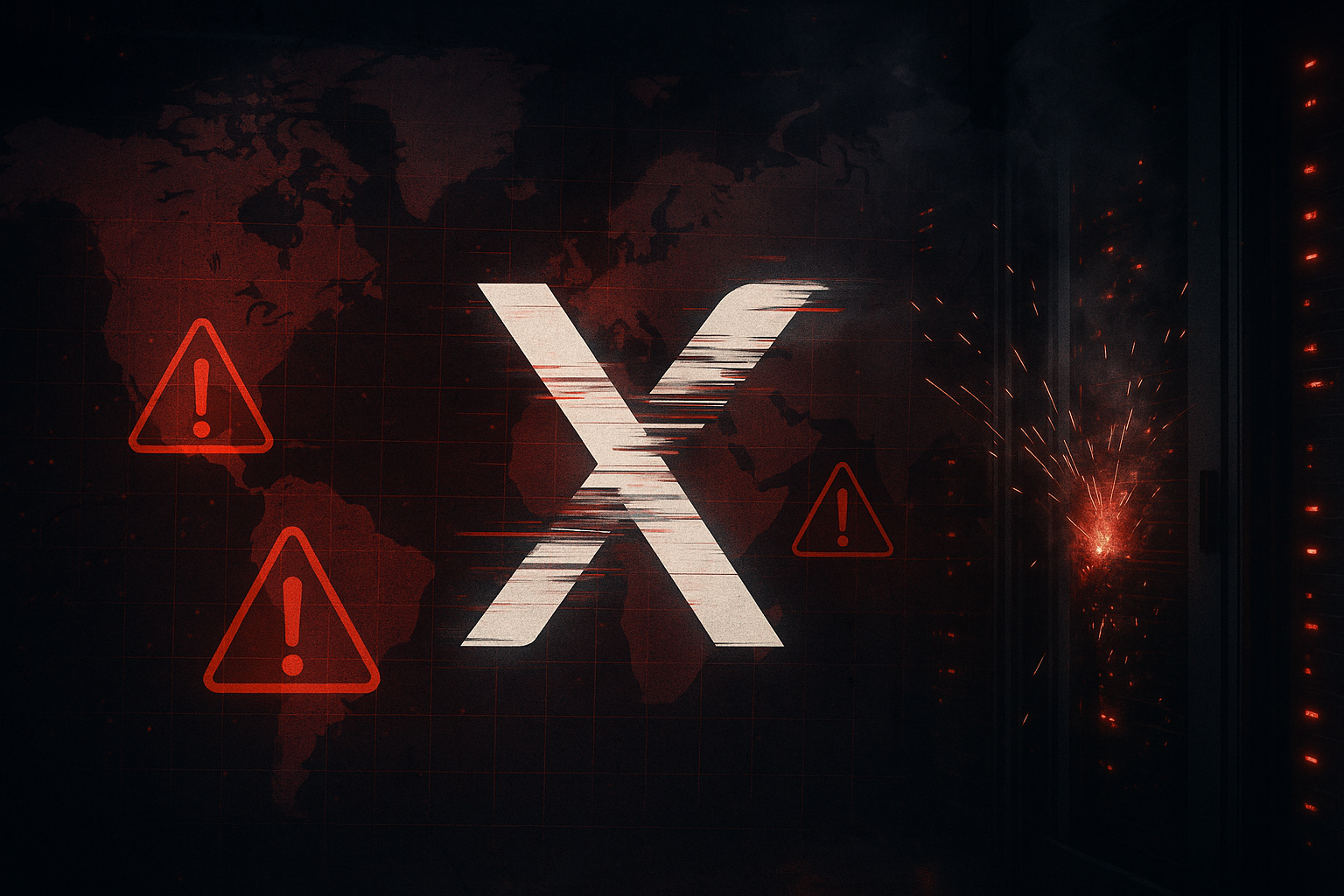Elon Musk’s social media platform X, formerly known as Twitter, has experienced severe operational disruptions over consecutive days in late May 2025, affecting millions of users across multiple continents and prompting acknowledgment from the platform’s owner of significant infrastructure failures. The widespread outages, attributed to data center malfunctions and failover system breakdowns, have highlighted critical vulnerabilities in the platform’s technical architecture and operational resilience.v
Timeline and Scope of the Global Outages
Initial Disruption and Escalation
The current wave of X platform disruptions began on Thursday, May 22, 2025, with service issues escalating dramatically over the following days. According to monitoring services, the problems intensified significantly on Saturday, May 24, with users reporting widespread accessibility issues starting around 1:00 PM local time. The outage tracker Downdetector recorded a substantial spike in user complaints, with reports climbing from 887 at 5:32 PM on May 23 to an alarming 25,756 by 5:02 PM on Saturday.
The disruption pattern revealed the global nature of the technical failure, with users across different time zones experiencing simultaneous service degradation. In the United States, approximately 25,000 users were reporting issues around 8:45 AM ET on Saturday morning, while users in India began experiencing major disruptions since 5:30 PM IST the same day. This temporal distribution suggests that the underlying technical problems affected X’s core infrastructure rather than region-specific systems.
Geographic Impact Assessment
The outage demonstrated a truly international scope, affecting users across multiple continents and countries. In the United Arab Emirates, Downdetector recorded a significant increase in complaints, rising from 87 reports at 7:22 PM on May 23 to 349 by 5:37 PM on Saturday. The platform’s disruption in India was particularly notable, with users across the country experiencing login difficulties, timeline access problems, and messaging functionality failures. Multiple countries reported similar patterns of login failures and website accessibility issues, confirming the global nature of the technical disruption.
The widespread geographic impact indicates that the outage stemmed from fundamental infrastructure problems rather than localized technical issues. Users in different regions experienced remarkably similar symptoms, including inability to access timelines, login failures, and direct messaging disruptions, suggesting that core platform services were compromised at the architectural level.
Technical Infrastructure Failures and Root Causes
Data Center Malfunctions and Fire Incident
The technical investigation into the outages revealed multiple infrastructure failures affecting X’s operational capacity. X’s official engineering team acknowledged that the initial disruption was attributed to a data center outage, with the @XEng account posting an official acknowledgment of the problem. More significantly, reports indicate that the recent outages have been linked to a fire at one of X’s data centers in Oregon, representing a serious infrastructure incident that compromised the platform’s service delivery capabilities.
The data center fire represents a critical infrastructure failure that exposed vulnerabilities in X’s disaster recovery and business continuity planning. Such incidents typically require extensive recovery procedures, including data restoration, system rebuilding, and comprehensive testing before full service restoration can be achieved. The fact that this physical infrastructure damage contributed to multi-day service disruptions suggests that X’s redundancy systems were insufficient to maintain operational continuity during such crisis events.
Failover System Breakdown
Perhaps more concerning than the initial infrastructure failure was the complete breakdown of X’s failover redundancy systems. Elon Musk publicly acknowledged this critical technical failure, stating that “major operational improvements need to be made” and specifically noting that “the failover redundancy should have worked, but did not”. This admission reveals fundamental flaws in the platform’s disaster recovery architecture and backup system design.
Failover systems are typically designed to automatically redirect traffic and maintain service availability when primary systems experience failures. The fact that these backup systems completely failed to function as intended suggests either inadequate system design, insufficient testing of disaster recovery procedures, or both. Modern social media platforms typically maintain multiple layers of redundancy specifically to prevent the type of widespread service disruption that X experienced during this incident.
User Experience and Service Impact Analysis
Functionality Disruptions Across Platform Features
The outages created comprehensive service disruptions affecting virtually all aspects of X’s functionality. Users reported a range of specific technical problems, including complete inability to log in, failure to access personal timelines, and inability to send or receive direct messages. When attempting to view new content, users encountered error messages reading “Something went wrong. Try reloading,” indicating fundamental problems with the platform’s content delivery systems.
The scope of functionality affected demonstrates that the technical problems reached deep into X’s core architecture. Beyond basic access issues, users experienced problems with both mobile applications and desktop website access, suggesting that multiple platform interfaces were simultaneously compromised. The fact that both primary user interaction methods were affected indicates that the underlying technical problems were not limited to specific client applications but extended to the platform’s backend infrastructure.
User Distribution and Complaint Patterns
Analysis of user complaint patterns revealed interesting insights into how the outage affected different user interaction methods. In the UAE, Downdetector data showed that 68% of complaints were related to the mobile app, 24% involved login issues, and 8% concerned the desktop website. This distribution pattern suggests that mobile users experienced disproportionate impact, possibly due to different technical architectures between mobile and web platforms or variations in how these systems handle server connectivity issues.
The concentration of mobile app problems may also reflect the reality that many X users primarily access the platform through mobile devices, making app-based issues more immediately noticeable and reportable. However, the significant percentage of login-related complaints across all platforms indicates that authentication systems were fundamentally compromised during the outage period, affecting user access regardless of their preferred platform interface.
Corporate Response and Leadership Acknowledgment
Musk’s Personal Commitment and Operational Changes
Following the widespread service disruptions, Elon Musk made a public commitment to intensive personal involvement in resolving X’s technical challenges. In a post on the platform, Musk announced his return to an extreme work schedule, stating he was “back to spending 24/7 at work and sleeping in conference/server/factory rooms”. This commitment extends beyond X to include his other ventures, as he indicated the need to be “super focused on X/xAI and Tesla (plus Starship launch next week), as we have critical technologies rolling out”.
Musk’s decision to adopt such an intensive work schedule represents an acknowledgment of the severity of X’s operational challenges and his personal responsibility for addressing them. His statement about sleeping in operational facilities suggests a hands-on approach to crisis management that goes beyond typical executive oversight. This level of personal commitment indicates that the technical problems may be more extensive and complex than initially apparent, requiring direct leadership intervention to resolve effectively.
Strategic Technology Development Context
The timing of these outages coincides with what Musk describes as critical technology rollouts across his business empire. His mention of upcoming Starship launches and developments at xAI suggests that X’s technical problems are occurring during a particularly demanding period for his attention and resources1. This context may explain both the severity of the current technical challenges and the intensity of his proposed response to address them.
The integration of X’s operational challenges with Musk’s broader technology portfolio raises questions about resource allocation and technical expertise distribution across his various ventures. The fact that he feels compelled to personally oversee technical operations suggests either insufficient technical leadership within X’s organization or the complexity of problems that require his direct intervention to resolve.
Conclusion
The consecutive global outages affecting X platform in late May 2025 represent a significant operational crisis that has exposed fundamental vulnerabilities in the social media platform’s technical infrastructure and disaster recovery capabilities. The combination of data center failures, including a fire incident in Oregon, and the complete breakdown of failover redundancy systems demonstrates critical gaps in X’s operational resilience that affect millions of users worldwide.
Elon Musk’s acknowledgment of these “major operational improvements” needed and his commitment to intensive personal involvement in addressing them signals both the severity of the current challenges and his determination to restore platform stability. However, the multi-day duration of service disruptions and the global scope of impact suggest that comprehensive infrastructure rebuilding and system redesign may be necessary to prevent similar future incidents. The platform’s ability to maintain user confidence and competitive position will likely depend on how effectively and quickly these fundamental technical challenges are resolved.

